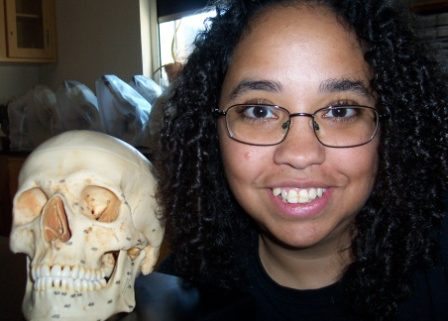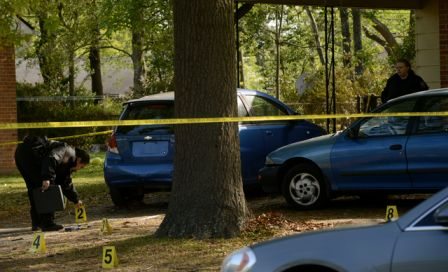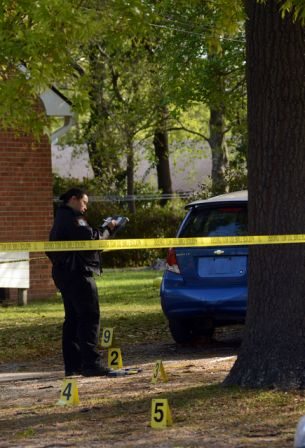Real-Life CSI Lisa Provost: Overheard On The Radio
On TV and in movies, police radios and radio chatter is usually depicted in clear, concise language, easy to understand, free of static and usually at some point includes the constant yelling of “Shots fired! Shots fired!” And while it is very possible to have calls for shots fired come across your radio in the average day, (much more so on Federal Holidays) it’s far from the only things announced over the airwaves.
Sometimes what you hear over the radio makes you pause. Sometimes it makes your heart stop. Other times, it makes you laugh hysterically and, upon listening to the radio, I am constantly reminded that the call you get is not always the call you get. It’s a common occurrence. You’ll get a call for a breaking and entering of a residence and it’s actually a larceny of motor vehicle. Or you’ll get a larceny from a motor vehicle call and it’s actually recovered stolen property. Or you’ll get a call for attempted breaking and entering of a residence and it’s an arson call. The information given by the 911 caller is usually never 100% correct but it’s the information given to patrol because it’s the only information they have to give. It’s up to patrol, and sometimes the forensic technicians once we get on scene, to truly determine what the call is actually in reference to.
Over the past few years I’ve had the opportunity to intern with three different law enforcement agencies and now I have the pleasure of working for one. As an intern I listened to the radio chatter and tried to keep up with what was going on and where. It’s not an easy task to do some days. At times you have multiple units having multiple conversations, dispatch sending multiple units to multiple locations, forensic units being dispatched all over the city and more. Through all of the static, wind noise, feedback, echoes, sirens blaring, dogs barking and people screaming in the background while others are trying to relay information, you can understand why I chuckle when I hear a crystal clear dispatch on a TV show.
But I digress… I carry a radio of my very own now. It is my lifeline. It is how I get dispatched to calls. How I let my colleagues, dispatch and everyone on the road know where I am, what I’m doing and if I need assistance. Watching a movie where an officer’s radio either gets shot, damaged and/or is inoperable, I now understand the fear the director and writer is trying to portray. Without my radio I feel almost naked. When I am in areas where I am experiencing heavy static and/or my radio cannot connect, I am keenly aware of how vulnerable I am at that very moment.
So with all of that in mind, I thought I would share some things I’ve heard over the radio over the years. Since each department calls their dispatch something else (Command, CQ, Comm, City, etc) I’ll just use what we do where I work. We call dispatch “City”. And of course all the addresses listed are not the actual addresses for the calls that came across the radio. (You know the drill… names and locations have been changed to protect the family… etc, etc.)
To make it a bit easier for folks to understand some of the following radio chatter, here are some ten-codes commonly used. While not all ten codes are universal in all departments across the nation, the following seem to be pretty common in most departments (well… in my experience so far):
10-3 – Hold radio traffic
10-4 – Okay, Understood, Yes, Correct
10-9 – Repeat
10-10 – Negative
10-14 – Information and/or message
10-67 – Found body
In the city I work for we have three radio channels we work with. As a forensic technician, I am dispatched from channel 2. I will move to channels 1 and 3 but I must always return to channel 2 when I clear a call. One thing you of course have to do is check back in service on your channel. But is the channel clear? Can you talk? Is another unit clearing a house and asked for dispatch to hold traffic? Is there a chase going on and vital information is flowing that cannot afford to be interrupted? You don’t know so you ask:
Me: City, channel clear?
(And sometimes you hear…)
City: 10- *static*
Me: *waits*
Me: *waits* City, channel clear?
City: 10- *static*
Me: *waits*
Officer: (Obviously doing the same thing) City, channel clear?
City: 10- (line cuts out)
So of course you’re thinking… is it 10-3? 10-4? 10-9? 10-10?! You don’t want to keep being that person that is attempting to check back in service while someone else is attempting to locate a suspect in a house and every time you key up on the radio you are potentially giving away their position, now do you? Thankfully, the dispatch in our city is used to heavy static in some areas and will usually respond:
City: Channel is clear.
Now that we’ve gotten all that prep out of the way, here are a few calls I remember well as they came in over the radio. Remember, when dispatch is relaying information, this is usually all the information they are being given by the 911 caller (while they are usually still connected with the 911 caller). And sometimes it is all the information they will ever get.
City: All units, be on the lookout for a white female, behind the Waffle House. Possibly hungry.
Officer: City, do you have a clothing description?
City: 10-4. No pants.
Officer: City, any further?
City: 10-10. Caller advises woman. Hungry. No pants.
The situation ended up being a woman was high on illegal narcotics, had attempted to steal food and was now attempting to trade sex for money in order to pay for said food.
City: All units, be on the lookout for a white male wearing a baseball cap driving a pickup truck.
(…a very, very long pause on the radio…)
Officer: City, can you narrow that description down any?
City: 10-4, the vehicle is a green truck.
(Note: This was in a rural county where half the population is male and approximately 75% of the population is Caucasian and a lot of folks drive trucks and wear baseball caps). I looked at the officer I was riding with and said “Well, I can narrow down two guys for you. My husband doesn’t wear baseball caps and drives a black Jeep, and you…you’re not wearing a hat and currently driving a white SUV.” He laughed and replied “Well, that leaves about 60,000 more guys to check!”
The situation ended up being a verbal disturbance between a couple where the female kicked the male out of the house and upon him leaving decided he was taking the truck. She was upset because that left her with a beat up old car and not the pretty new truck. So she called the vehicle in as stolen even though it was legally not hers. Police did end up finding the male in question. The male was not charged with any crime.
City: All units, be on the lookout for a male wearing black walking north on Main Street.
Officer: City, can you advise race? Or age?
City: 10-10.
Officer: City, can you advise direction of travel?
City: 10-10.
Officer: City, can you advise a nearby cross street?
City: 10-10.
(Note: The road in question was approximately 5 miles long, 8 lanes wide, with numerous cross streets, commercial areas and residential complexes and with the average of 100,000 people a day traveling over it.)
The situation was a verbal disturbance between a male and a female where the male decided he was just going to walk away from the argument instead of letting it escalate. The female, enraged at his walking away from her, called 911 stating he had attacked her (he had not) and gave the above description. Police did find the male in question. They found him because as an officer pulled up to a male wearing black on the sidewalk, he yelled “Oh that bitch called you didn’t she?!” The male was not charged with any crime.
City: Unit in the area of ABC Cemetery, be advised we have received a call, reference a 10-67 at this location.
Rookie Officer: (Snickering slightly) City, are you saying someone found a dead body at the cemetery?
City: 10-4.
Rookie Officer: (A pause after keying up the mike and then, sounding incredulous) Above ground?!
City: (With the sound of someone roaring with laughter behind her) 10-4.
The situation was not a dead body at the cemetery but an intoxicated male who was walking home from a bar and decided to take a nap. In the cemetery.
City: Unit, respond to Wendy’s on Main Street, reference a large disturbance between at least 20 people.
Officer: 10-4 enroute.
City: For 10-14, be aware it’s in reference to a female being given a ring by a male and others on scene being upset.
Officer: 10-4.
City: For 10-14, be aware the caller states numerous other vehicles are pulling into the parking lot. Caller is worried the violence will escalate.
Officer: 10-4.
The situation was a young man was on one knee, displaying a ring, and proposing marriage to his girlfriend. A few intoxicated people began cheering loudly for the newly engaged couple. Other intoxicated people at the restaurant were upset that the first group of intoxicated people was being so loud. A full on brawl ensued. The other vehicles driving into the parking lot were just there for the drive-thru and had no part in the brawl. The newly engaged couple was not injured and had already left the scene by the time officers arrived. Multiple people were detained for fighting.
City: Unit, respond to 123 Main Street, reference yelling and a dog barking loudly.
Officer: 10-4, enroute.
(A few minutes later….)
Officer: City, there is no dog at this location. Just loud music playing next door. I believe the song is called “Who Let the Dogs Out?”
City: 10-4. Caller advises barking dog.
Officer: (Obviously amused) 10-4 City. I will let the caller know no dogs are out or barking.
The situation was literally, a neighbor had “Who Let the Dogs Out?” on repeat at full blast on his stereo and an elderly neighbor thought a dog was in distress so she called 911.
I could go on and on but I’ll leave you with my favorite call so far. I did not hear this one personally but it was relayed for me by colleagues and I just had to add it:
City: Unit, respond to 123 Main Street in reference to an animal with a head like a snake and the body of an alligator.
Officer: City, do you have any further on description? Size?
City: 10-10.
Officer: City, is the caller stating the animal is aggressive?
City: 10-4.
Officer: 10-4, enroute.
(A few minutes later…)
Officer: City, on scene.
City: 10-4.
(A few minutes later…)
Officer: City… the salamander has been released.
City: (with the sound of lots of laughter behind her) 10-4.
The situation was a lady had found a skink (a two to three inch long lizard) in her kitchen and contacted 911, hysterical with fear, with the above description.
Lisa Provost graduated with a Bachelor’s in Forensic Biology with a concentration in Criminal Justice and currently serves as a Forensic Technician with a police department in a large U.S. city. Some of you may remember meeting Lisa at a past Writers’ Police Academy.








Those are great! As a writer, I think all the time about escalating what the call might be for but never thought I could just completely change it!!!
Too funny!
Priceless!
Lee, forgive me if I’m wrong, but I was under the impression that you were retired. Is this not the case?
She should write these in a notebook. There’s a novel in there somewhere. Funny stuff.
These are priceless. I’m laughing so hard it is difficult to type.